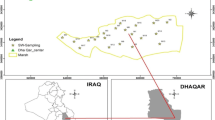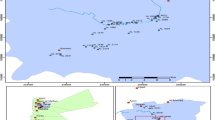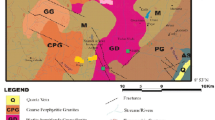Abstract
During the pre-monsoon season (June, 2013), 115 groundwater samples were collected randomly at different depths in Cox’s Bazar paleobeach and its vicinity. The collected samples were analyzed by inductively coupled plasma mass spectrometry (ICP–MS). Studies showed that the higher values of radionuclides (i.e., U, and Th) were observed in the shallow depth of tubewells (5–50-m depth) with ranges of 0.01–9.70 and 0.01–127.10 μg/l, a mean of 0.47 and 1.38 μg/l, and a median of 0.13 and 0.01 μg/l, respectively. Uranium concentration in all drinking water samples was found to below the safe limit of 30 μg/l (WHO, Guidelines for drinking-water quality, 2011). When we compare our measured U contents in the drinking water to the WHO (WHO, Health Criteria and Other Supporting Information – Addendum, 1998) and Japanese drinking water recommendation level of 2 μg/l, we found about 5 % shallow exceeded this limit, although WHO health-based drinking water guidelines were not determined so far for Th. High concentrations of Mn (0.01 to 28.64 mg/l), Fetotal (0.01 to 88.89 mg/l), and B (13 to 969.50 μg/l) were also observed for 87, 60, and 7 % of tubewell water, respectively, some of which exceeded their WHO (WHO, Guidelines for drinking water quality, 2004) drinking water guidelines. Based on the spatial distribution of the tubewells with elevated concentrations of Mn, Fe, B, U, and Th, about 85 % of the study area has been contaminated with at least one of these elements. No direct correlation was found, but a weak positive correlation was observed between the concentrations of radionuclides (i.e., U and Th) belonging to total dissolved solid (TDS), alkalinity as HCO3, and the heavy metals, i.e., Mn, Fetotal, and B. However, the high concentrations of radionuclides along with heavy metals observed particularly in certain areas can be attributed due to interaction of groundwater with the local subsurface geology of the area. Since the radionuclides and heavy metals can have toxic effect and also the levels were considerable to those compared to the WHO drinking water guideline values, the results will serve to arouse public interest and lead to much research on a potential health hazard in the area studied.







Similar content being viewed by others
References
Adams S, Titus R, Pietersen K, Tredoux G, Harris C (2001) Hydrochemical characteristics of aquifers near Sutherland in the Western Karoo, South Africa. J Hydrol 241:91–103
Allard T, Ildefonse P, Beaucaire C, Calas G (1999) Structural chemistry of Uranium associated with Si, Al, Fe gels in a granitic uranium mine. Chem Geol 158:103
ATSDR (1999) Toxilogical profile for uranium. US Department of Health and Human Services, Agency for Toxic Substances and Disease Registry, Atlanta
Balaram V (1993) Characterization of trace elements in environmental samples by ICP-MS. At Spectrosc 14(6):174–179
Bricker O P and Jones B F (1995) Main factors affecting the composition of natural waters, In: Salbu B, Steines E (eds). Trace metals in natural waters. Chapter 1, CRC Press, pp. 1-19.
Brugge D, Buchner V (2011) Health effects of uranium: new research findings. Rev Environ Health 26:231–249
Bucur C, Olteanu M, Pavelescu M (2006) Radionuclides diffusion in geological media. Rom J Phys 51(3–4):469–478
Chowdhury MI (2003) Potentiality of radioactive materials occurring as assemblages with placer minerals in Cox’s Bazar beach area, BSMEC/TR-1/2003. Beach Sand Minerals Exploitation Centre, Cox’s Bazar
Earth Summit (1992) Programme of action for sustainable development (174–175). Agenda 21. UNCED, Rio de Janeiro
E.C.R (Environmental Conservation Rules of Bangladesh) (1997) Environmental Conservation Rules. Ministry of Environment and Forest, Government of the People’s Republic of Bangladesh. Bangladesh Gazette, Extra-ordinary Issue of 28
Edmunds WM, Carrillo-Rivera JJ, Cardona A (2002) Geochemical evolution of groundwater beneath Mexico City. J Hydrol 258:1–24
Grenthe I, Stumm W, Laaksuharju M, Nilsson AC, Wikberg P (1992) Redox potentials and redox reactions in deep groundwater systems. Chem Geol 98(1):131–150
Gueniot B, Munier-Lamy C, Berthelin J (1988) Geochemical behaviour of uranium in soils, part II. Distribution of uranium in hydromorphic soils and soil sequences. Applications for surficial prospecting. J Geochem Explor 31:39–55
Hem J.D. (1989) Study and Interpretation of the chemical characteristics of natural water, U.S. Geological Survey Water-Supply Paper 2254, 3rd ed., 263 p.
Hsi CK, Langmuir D (1985) Adsorption of uranyl onto ferric oxyhydroxides: application of the surface complexation site-binding model. Geochim Cosmochim Acta 49:1931–1941
ICRP (2007) Recommendations of the International Commission on Radiological Protection. Pergamon Press, Oxford
Kumar A, Rout S, Narayanan U, Mishra MK, Tripathi RM, Singh J et al (2011) Geochemical modeling of uranium speciation in the subsurface aquatic environment of Punjab State in India. J Geol Min Res 3(5):137–146
Kawabata Y, Yamamoto M, Aparin V, Ko S, Shiraishi K, Nagai M, Katayama Y (2006) Uranium pollution of water in the western part of Uzbekistan. J Radioanal Nucl Chem 270:137–141
Langmuir D, Hall P, Drever J (1997) Environmental geochemistry. Prentice Hall, New Jersey
LaFlamme BD, Murray JW (1987) Solid/solution inter action: the effect of carbonate alkalinity on adsorbed thorium. Geochim Cosmochim Acta 51:243–250
Lawrie WC, Desmond JA, Spence D, Anderson S, Edmondson C (2000) Determination of radium-226 in environmental and personal monitoring samples. Appl Radiat Isot 53(910):133–137
National Research Council (US) Safe Drinking Water Committee (1977) Drinking water and health, vol 5. Amendment to the Safe Drinking Water Act, Washington
NRC-NAS (1980) “Recommended dietary allowances”, 9th edn. Food and Nutrition Board, National Research council, National Academy of Sciences, Washington
Orloff KG, Mistry K, Charp P (2004) Human exposure to uranium in groundwater. Environ Res 94(3):316–326
Rahman J, Bari Z, Chodhury KR, Suzuki S (2008) Heavy mineral composition of the Neogene sandstones and beach sands across the Inani-Dakhin Nhila area, Southeast Bangladesh: implications for provenance. J Sedimentol Soc Jpn 67:3–17
Seddique AA, Sabbir Hossain SK, Shaibur MR, Hoque MA, Ahmed KM, Alam N (2013) Landuse changes over 21 years and impact on groundwater aquifer in and around Cox’s Bazar town, Bangladesh. Int J Environ 3(1):19–26
Seddique AA, Hoque A (2015) Heavy mineral assemblages at Cox’s Bazar paleo-beach core sediments, Cox’s Bazar, Bangladesh. Int J Emerg Technol Adv Eng 5(9):264–269
Subba Rao N (1993) Environmental impact of industrial effluents in groundwater regime of Visakhapatnam industrial complex. Indian J Geol 65:35–43
Subramani T, Elango L, Damodarasamy SR (2005) Groundwater quality and its suitability for drinking and agricultural use in Chithar River Basin, Tamil Nadu, India. Environ Geol 47(8):1099–1110
WHO (1984) International standards for drinking water. World Health Organization, Geneva
WHO (1998) Guidelines for drinking-water quality. In: Health criteria and other supporting information—addendum, vol 2, 2nd edn. World Health Organization, Geneva
WHO (2004) Guidelines for drinking water quality, 3rd edn. World Health Organization, Geneva
WHO (2008) Guidelines for drinking water quality, 3rd edn. World Health Organization, Geneva
WHO (2011) Guidelines for drinking-water quality, 4th edn. World Health Organization, Geneva
Zaman M, Schubert M, Antao S (2012) Elevated radionuclide concentrations in heavy mineral-rich beach sands in the Cox’s Bazar region, Bangladesh and related possible radiological effects. Isot Environ Health Stud 48:512–525
Zamora ML, Tracy BL, Zielinski JM, Meyerhof DP, Moss MA (1998) Chronic ingestion of uranium in drinking water: a study of kidney bioeffects in humans. Toxicol Sci 43:68–77
U.S. EPA (U.S. Environmental Protection Agency) (2008) Drinking Water Health Advisory for Boron,U.S. EPA, Office of Water, Office of Science and Technology, Washington, DC 20460. EPA Report 822-R-08-013, Available online at https://www.epa.gov/sites/production/files/2014-09/documents/drinking_water_health_advisory_for_boron.pdf
Acknowledgments
The authors thank the Higher Education Quality Enhancement Project (HEQEP) and the World Bank for financial support through the HEQEP Sub-project (CP-309). Special thanks are due to Mr. Manik, Beach Sand and Mineral Exploration Center, Bangladesh Atomic Energy Commission, Cox’s Bazar, for his technical support.
Author information
Authors and Affiliations
Corresponding author
Additional information
This article is part of the Topical Collection on Water Resources in Arid Areas
Rights and permissions
About this article
Cite this article
Seddique, A.A., Masuda, H. & Hoque, A. Radionuclide and heavy metal contamination in the paleobeach groundwater, Cox’s Bazar, Bangladesh: potential impact on environment. Arab J Geosci 9, 488 (2016). https://doi.org/10.1007/s12517-016-2511-x
Received:
Accepted:
Published:
DOI: https://doi.org/10.1007/s12517-016-2511-x




